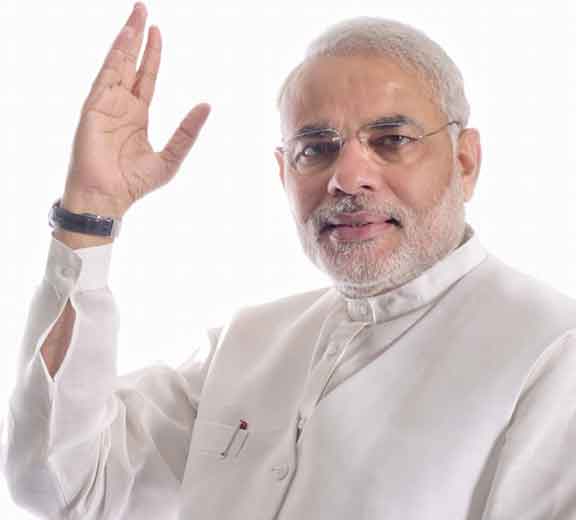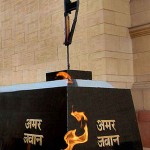IDR Blog
What is Modi’s military vision?
Recently I had written in these pages on the importance of Narendra Modi’s strategic vision. That was dominated by the theme of foreign policy. But what about Modi’s military vision? This question is relevant as the accident involving a submarine has led to the unprecedented resignation of the chief of the naval staff who had 15 months of his services left. In fact, over the last six months there have been two submarine accidents that cost nine lives, with one submarine getting completely destroyed and another grounded.
Modi, if elected as the Prime Minister, has to go deeper in fixing the problem that inhibits India from developing a sound defence industrial policy (DIP).
The overall security situation of India is not in a state of happy affairs. We may not be in a desperate situation, but our capacity to withstand our enemies, both outside and inside, is terribly low, thanks to the lack of clarity and decisiveness under the 10 years’ rule by the UPA. A K Antony has emerged as the country’s logiest serving defence minister, but his critics view him to be India’s worst defence minister so far. There are simply no questions about Antony’s impeccable honesty and integrity. But as far as his concrete achievements are concerned, his years in the South Block are widely believed to be years of missed opportunities, thanks to his inability in taking right decision at right time.
Despite Antony’s mantra of probity and transparency, his tenure as defence minister has been marked by serious scandals over Ordnance Factory Board scam, Tatra-BEML military vehicle scam, VVIP chopper scam and of late the Rolls-Royce-HAL scam, to name a few. His obsession with transparency saw more cancellations of defence orders and blacklisting of prime defence firms from South Africa, Israel and Singapore, adversely affecting the military health and making him highly unpopular in all the three wings of the military.
Under the UPA rule, the Defence Procurement Procedure (DPP) has been amended several times, most recently in April 2013, to strengthen the transparency in buying arms and helping simultaneously the process of indigenisation. But it has failed to satisfy the users of the end-products, the armed forces. The DPP, all told, remains flawed, with its extreme slow-moving processes. Each case of acquisition of arms and ammunitions that emanates from the Service Head Quarters is required to be steered through multiple layers of bureaucracy that exist in four departments of the Ministry of Defence(MoD) as well as its Finance Wing, and finally in the Ministry of Finance. After this, some cases need approval of the Cabinet Committee on Security. Queries are sequential and often repetitive, and every file-movement takes weeks, if not months. In fact, this process is the chief cause of scams that one often comes across in defence procurements, because, bribes are paid essentially to circumvent the tedious procedures.
No wonder why all the three wings of Indian military are short of critical components; that too at a time when the geopolitical environment is getting vitiated with each passing day.
If the Defence expenditure as percentage of Gross Domestic Product (GDP) is taken into consideration, the growth is declining since the year 2009-10. During the year 2009-10 the growth was 2.20% which has come down 1.74 per cent in this year’s interim budget. The Defence expenditure as the percentage of total Central Government expenditure as such has declined from 13.84% in 2009-2010 to 12.70 per cent of the total central government expenditure in the latest interim budget. The Defence expenditure as compared to some of the European and neighbouring countries indicates that it as percentage of GDP in India is lowest as compared to U.S., China, France, U.K., Russia and Pakistan.
No wonder why all the three wings of Indian military are short of critical components; that too at a time when the geopolitical environment is getting vitiated with each passing day. In 2011, the then Indian Army chief General VK Singh wrote a letter to Prime Minister Manmohan Singh , saying that the Indian Army’s combat weapons were in such a poor condition that they made India unfit for war! There is shortage of armament and tank ammunition. The deficiency of gun systems has been allowed to reach to the criticality. Indian soldiers do not have even enough bullet-proof jackets.
As regards the Indian Air Force (IAF), UPA’s years have been marked by huge gap between the required and existing strength of Squadrons with the Air Force. The IAF presently has 34 fighter squadrons against the sanctioned strength of 42 squadrons. But the number of fighter squadrons is likely to reduce further to 31 during the 12th Plan period. What is more worrying is the fact that the IAF’s fighter aircraft fleet is quite old and is on the verge of phasing out. Given the fact that life span of aircraft is defined in terms of Total Technical Life (TTL) and the normal technical life of MiG Aircraft ranges from 15 to 40 years from different variants, it is natural that MIG-23MF, MIG-23 BN and MIG-25 have stopped flying. T-69/69B (Trainer), T-75 (BIS) and (BISON), T-77 (BADAL) T-96 (TRISHUL) are already 40 or more than 40 years old. MIG 29 have more than 25 years of life. Similarly, Mi-25/35, Mi-8 and Mi-17 helicopters are more than 29 years old. The different variants of MiG-21s and MiG-27s are being phased out during the 12th and 13th Plan period which is supposed to see the induction of Su-30 MKI, Medium Multi Role Combat Aircraft (MMRCA), Light Combat Aircraft (LCA) and Fifth Generation fighters as replacement. But the induction process has not been commensurate with the need of the IAF. The long delay in acquiring MMRCA is also badly hurting the IAF’s fighting capability. The deal with French company Dassault which makes Rafale, was okayed about three years ago, but is yet to be inked as the cost negotiation committee has not finished its work. Besides, there are acute shortages of trainer aircraft and simulators.
Similarly, capital funds of less than 8 percent of the naval budgets are highly inadequate to procure and build the systems in pipeline – Aircraft Carrier, Frigates, offshore patrol vessel and survey catamarans. The front of submarines appears problematic. The acquisition of the Scorpène submarines has been already delayed. The procurement of the next P-75I – a batch of six submarines to be procured sooner rather than later. Then there is the vital question of weapons systems for the submarine fleet as a whole, not to speak of the rationalisation of surface ship-based anti-submarine warfare capabilities of a true Blue water Navy that IN dreams of becoming. It may be noted that of the total of 138 platforms, both ships and submarines that the Navy has, more than half of them are 20 years old and need to be refitted and modernised.
There is a tremendous shortage of qualified engineers and scientists in our defence sector. You may frame enough provisions or rules for technology transfer and offsets with regard to the foreign vendors.
As if this is not bad enough, despite all talks of indigenisation, India still imports 70 percent of its military equipments; in fact, it is the largest importer of arms in the world. According to an estimate, the defence market in India offers a $180 billion opportunity for the foreign vendors during the period 2013-2020 and offset opportunities are expected to be around $15 billion within next 10-15 years.
It is against this background that one would like to know what Modi, if elected as the Prime Minister, will do. So far one has not heard much from Modi on military matters except his bold assertion at a rally of the ex-servicemen in Hissar that he would ensure ‘one rank one pension” scheme for 24 lakh ex-servicemen, an assertion that seemed to have forced the UPA government to go for the scheme in the interim budget it presented last month. Rahul Gandhi may take the credit for this now, but that should be Modi’s arguably. Of course, Modi is in favour of India developing a strong defence industry. As defence analyst Deba R Mohanty has pointed out elsewhere, in January 2013, at an international conference on ‘defence offsets’ as part of the 6th Vibrant Gujarat Global Investors’ Summit (VGGIS), Modi called for framing a holistic policy to make India self-reliant in defence production for the security forces alongside training skilled human resources. Secondly, a special economic zone promoted by Gujarat Industrial Development Corporation (GIDC), devoted exclusively to manufacture of niche electronic products, had attracted global arms majors like Lockheed Martin for material and scientific knowledge investment some time back, although nothing much happened due to, what Mohanty points out, the inaction on the part of the central government. Thirdly, in his recent address to the NASSCOM, Modi said: “we have to emphasize indigenous electronics manufacturing in strategic sectors like defence. Indian military assets, both existing and future procurement, contain sizeable import components in electronics and information technology domains, which is a very serious problem”.
However, in my considered view, Modi, if elected as the Prime Minister, has to go deeper in fixing the problem that inhibits India from developing a sound defence industrial policy (DIP). The most fundamental flaw in our DIP is that we have not spent enough on our research and development (R&D). It is very easy to criticize the Defence and Research Development Organisation (DRDO), but the fact remains that the DRDO’s share in our defence budgets is not much to talk about if one compares the sums that the major arms exporters invest in R&D. Our brightest students do not go for R&D. There is a tremendous shortage of qualified engineers and scientists in our defence sector. You may frame enough provisions or rules for technology transfer and offsets with regard to the foreign vendors. But what use they are if you fail to utilise them because of the essentially faulty personnel policy?
Post your Comment
2 thoughts on “What is Modi’s military vision?”
 Loading Comments
Loading Comments





I do not expect the BJP to do wonders – they botched up the Kargil affair. How serious are they will be dictated by the choice of who will be defence minister. Like previous Governments picked up the most worthless people as defence ministers . How could somebody make a primary school teacher as the defence minister of India? Mulayam Singh !! Then you have a rabble rousing union leader as the defence minister. George Fernandez !”!! Are we really serious??
Mr. Nanda’s article is timely and thought provoking. Modi has not stated in clear terms what his defense strategy will look like once elected. It is perhaps the best response at this juncture. From his political statements, however, one can see his preference for a new defense doctrine. China and Pakistan will see a different push back should they embark on a new adventure. Towards that goal India must focus on building a credible defense independent of global trade and interconnectedness of relationships. Technology and Industrialization backed by progressive economy of the nation is a fundamental requirement. We must not lose sight of the fact that, in this day and age a military style war between nations on any level is an obsolete idea no matter how you cut it. The purpose of a strong defense structure is not to start a war but to prevent it, by making it clear to the potential adversary the price of war as an unaffordable option. This has been the basis of détente between the superpowers since the end of the second world war. It stands as a model for India-China to follow.